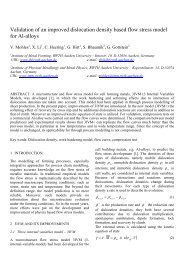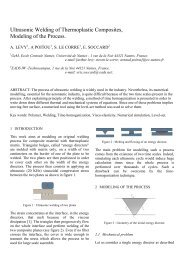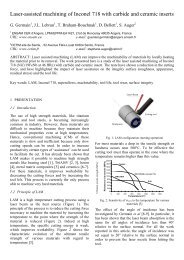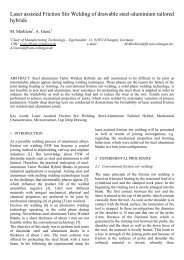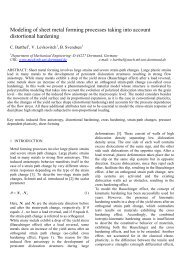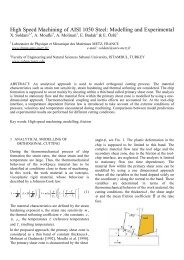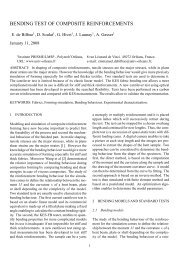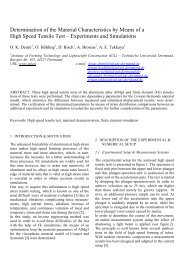Here - the ESAFORM 2008 Conference - INSA de Lyon
Here - the ESAFORM 2008 Conference - INSA de Lyon
Here - the ESAFORM 2008 Conference - INSA de Lyon
Create successful ePaper yourself
Turn your PDF publications into a flip-book with our unique Google optimized e-Paper software.
Performance enhancements of die casting tools trough PVDnanocoatingsM. Rosso 1 , D. Ugues 1 , E. Torres 1 , M. Perucca 2 , P. Kapranos 31 Politecnico di Torino – Cso Duca <strong>de</strong>gli Abruzzi, 24, 10129 Turin (Italy)URL: www.polito.it e-mail: mario.rosso@polito.it; daniele.ugues@polito.it;eloy.torres@polito.it2 Clean NT Lab, Environment Park - Via Livorno, 58/60, 10144 Turin (Italy)URL: http://www.cleanntlab.com/e-mail: massimo.perucca@envipark.com3 The University of Sheffield - Mappin Street, Sheffield, S1 3JD, United KingdomURL: www.shef.ac.uk/materialse-mail: p.kapranos@shef.ac.ukABSTRACT: Wear and failure of die casting dies involve a complex interaction between variousmechanisms. The most important wear and failure mo<strong>de</strong>s are summarized as follows: (i) <strong>the</strong> so-calledwashout damages on working die surfaces are attributed to erosion, corrosion and sol<strong>de</strong>ring; (ii) <strong>the</strong>rmalfatigue is <strong>the</strong> most important failure mo<strong>de</strong> in die casting. The sector of surface thin PVD coatings isconstantly enhancing in or<strong>de</strong>r to meet <strong>the</strong> increasing <strong>de</strong>mand for improved performances of tooling.Advanced PVD coatings are <strong>de</strong>signed to withstand severe mechanical and <strong>the</strong>rmal stress conditions. ACrAlSiN nanostructured coating system was <strong>de</strong>posited on <strong>the</strong> base material, modulating <strong>the</strong> chemicalcomposition so as to increase ei<strong>the</strong>r <strong>the</strong> chromium or <strong>the</strong> aluminium-silicon content. Then, ano<strong>the</strong>r set ofspecimens was subjected to a cyclic immersion program in a molten aluminium bath. The washout signs were<strong>de</strong>tected and monitored in function of <strong>the</strong> increasing number of cycles.Key words: PVD ceramic coatings, aluminium die casting, washout, sol<strong>de</strong>ring, modulated PVD composition1 INTRODUCTIONThe process of aluminium die casting presents acomplex phenomenon of <strong>de</strong>gradation, whereerosion, sol<strong>de</strong>ring, corrosion, <strong>the</strong>rmal fatigueusually occur jointly. All of <strong>the</strong>se phenomena aremajor sources of limitation to <strong>the</strong> die castingsservice life. The application of hard PVD coatingsmay result efficient against <strong>the</strong>se <strong>de</strong>gradationmechanisms when applied on particular parts of <strong>the</strong>die: e.g. <strong>the</strong> inlet and <strong>the</strong> pins.The <strong>de</strong>velopment of physical vapour <strong>de</strong>position(PVD) has provi<strong>de</strong>d engineers and systems<strong>de</strong>signers with <strong>the</strong> ability to tailor <strong>the</strong> surfaceproperties of a range of mechanical <strong>de</strong>vices to suit agrowing range of applications. Advanced PVDcoatings are <strong>de</strong>signed to withstand severemechanical and <strong>the</strong>rmal stress conditions.Generally, <strong>the</strong> main requirements expected byadvanced coatings are high hardness andcompression strength, high wear resistance, highmechanical and <strong>the</strong>rmal fatigue resistance and lowfriction coefficient. These parameters may beattained by properly functionalising tools surfaceswith innovative targeted thin films.Fur<strong>the</strong>rmore, <strong>the</strong> adhesion strength at <strong>the</strong> interfacebetween coating and substrate results of majorimportance to guarantee a long endurance of <strong>the</strong> toollifetime and surface properties. In <strong>the</strong> recent years,single layer, multilayer and gradient microstructureshave been <strong>de</strong>veloped and now, withtesting of different coating chemistry andstoichiometry, representing <strong>the</strong> cutting edgesolutions in coating technology.The present paper reports <strong>the</strong> results of a research on<strong>the</strong> effect of PVD films applied on a heat treated hotwork tool steel substrate. The aim of this study wasto <strong>de</strong>termine <strong>the</strong> behaviour exhibited by eachcoatings in relation with <strong>the</strong> modulated chemicalcomposition. To this purpose a set of coatedspecimens with chemical composition variationsbased on <strong>the</strong> CrAlSiN system were produced



